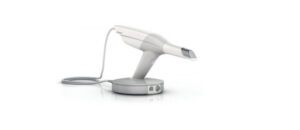TRIOS Digital Impression Scanning
Intraoral scanner: An innovative precision digital impression technology
 The innovative digital impression technology is growing expeditiously with advanced features & benefits to the dentists & patients by creating a replica of soft & hard tissues generated by computer via use of lasers & other optical scanning devices.
The innovative digital impression technology is growing expeditiously with advanced features & benefits to the dentists & patients by creating a replica of soft & hard tissues generated by computer via use of lasers & other optical scanning devices.
Why digital impressions?
The intraoral scanner captures exact/precise details of one’s impression avoiding the use of traditional impression materials that were quite messy & troublesome (due to gag) for some patients. Once the scanning is completed the data is transferred to a computer & used to create restorations.
Many patients find this technology more convenient as this avoid their one of the most vexatious experiences of taking dental impressions in dental offices.
Benefits of digital impressions
 Incorporation of digital impressions technology into dental practice remarkably increases accuracy & efficiency, & makes it feasible to mail the virtual impression to the lab, rather than sending a stone model.
Incorporation of digital impressions technology into dental practice remarkably increases accuracy & efficiency, & makes it feasible to mail the virtual impression to the lab, rather than sending a stone model.
Also via use of such technology, same day restorations can be delivered to the patients, henceforth speeding up the treatment & minimizing the need for multiple visits to the dental office.
Other benefits include:
- REDUCED CHAIR TIME
- PRECISE IMAGE QUALITY FOR ACCURATE FITTING OF RESTORATIONS.
- HIGHLY COMFORTABLE FOR PATIENTS AS THE ERGONOMIC DESIGN ALLOW EASY & COMFORTABLE PLACEMENT IN THE PATIENT’S MOUTH.
- REDUCED LIKELIHOOD OF IMPRESSION TAKING ERRORS.
- INCREASED PATIENT EDUCATION & AWARENESS AS THEY CAN SEE THE MINUTE DETAILS ON THE SCREEN & CAN UNDERSTAND QUITE WELL.
- THE PATIENT’S RECORD CAN BE EFFICIENTLY STORED ELECTRONICALLY AVOIDING CONFUSIONS.
Procedure
The procedure involves capturing digital impression via use of intraoral wand. The wand is inserted into patient’s mouth & moved over the teeth & soft tissues. The captured digital impressions will be displayed on the screen.
It takes few minutes to capture a digital impression of prepared tooth/teeth & approx few seconds to record the opposing arch. During the review of the image, one can enlarge & manipulate the possible errors & can correct onscreen before sending it to the laboratory.
What makes digital impressions different from the traditional impressions?
The conventional or traditional impression making procedure involves use of numerous materials & at times more steps or visits. Also, this procedure has increased chances of errors like air bubbles, voids, inaccurate mixing, distortions etc.
Whereas, digital impressions eliminate much of the physical work, chances of errors & conjecture associated with the traditional impressions. Concurrently they reduce chair side time during the impression as well as during the delivery of the restorations.
In many instances the fabrication of restorations can be speedy due to elimination of working time, setting time required with materials like dental stone.
With traditional impressions it’s quite difficult to evaluate errors. And, in case errors are identified, patient again will have to undergo the same procedure again, leading to discomfort & inconvenience.
Also, the use of digital scans allows a clinician to magnify the impression & evaluate carefully. In case one identifies errors, they can be corrected immediately before submitting the impression. Once scanning is completed, one gets to see the virtually articulated model on the screen.
The system also indicates insufficient tooth reduction (if present). This enables clinicians to modify the preparation immediately to ensure the precise fit of the final restoration.
At Dr. Sachdeva’s Dental Institute, we understand how messy & uncomfortable it can be to be stuffed with gooey stuff in someone’s mouth. However, to benefit our patients with the new dental impressions technology & avoid such discomfort, we have incorporated this innovative technology in our practice. With the help of 3shape Trios, we capture digital impressions that assure an accurate fitting of the final restoration.